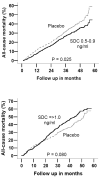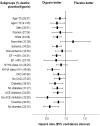Digoxin and reduction in mortality and hospitalization in heart failure: a comprehensive post hoc analysis of the DIG trial - PubMed (original) (raw)
Randomized Controlled Trial
Digoxin and reduction in mortality and hospitalization in heart failure: a comprehensive post hoc analysis of the DIG trial
Ali Ahmed et al. Eur Heart J. 2006 Jan.
Abstract
Aims: To determine the effects of digoxin on all-cause mortality and heart failure (HF) hospitalizations, regardless of ejection fraction, accounting for serum digoxin concentration (SDC).
Methods and results: This comprehensive post-hoc analysis of the randomized controlled Digitalis Investigation Group trial (n=7788) focuses on 5548 patients: 1687 with SDC, drawn randomly at 1 month, and 3861 placebo patients, alive at 1 month. Overall, 33% died and 31% had HF hospitalizations during a 40-month median follow-up. Compared with placebo, SDC 0.5-0.9 ng/mL was associated with lower mortality [29 vs. 33% placebo; adjusted hazard ratio (AHR), 0.77; 95% confidence interval (CI), 0.67-0.89], all-cause hospitalizations (64 vs. 67% placebo; AHR, 0.85; 95% CI, 0.78-0.92) and HF hospitalizations (23 vs. 33% placebo; AHR, 0.62; 95% CI, 0.54-0.72). SDC> or =1.0 ng/mL was associated with lower HF hospitalizations (29 vs. 33% placebo; AHR, 0.68; 95% CI, 0.59-0.79), without any effect on mortality. SDC 0.5-0.9 reduced mortality in a wide spectrum of HF patients and had no interaction with ejection fraction >45% (P=0.834) or sex (P=0.917).
Conclusions: Digoxin at SDC 0.5-0.9 ng/mL reduces mortality and hospitalizations in all HF patients, including those with preserved systolic function. At higher SDC, digoxin reduces HF hospitalization but has no effect on mortality or all-cause hospitalizations.
Figures
Figure 1
Kaplan-Meier plots for cumulative risk of death due to all causes by serum digoxin concentration (SDC)
Figure 2
Kaplan-Meier plots for cumulative risk of death due to all causes among patients matched by propensity to develop serum digoxin concentrations (SDC) 0.5-0.9 ng/ml and ≥1.0 ng/ml
Figure 3
Kaplan-Meier plots for cumulative risk of hospitalization due to worsening heart failure (HF) by serum digoxin concentration (SDC)
Figure 4
Hazard ratio (95% confidence interval) for all-cause mortality in subgroups of patients with heart failure with serum digoxin concentration 0.5-0.9 ng/dL and placebo (ACE= angiotensin-converting enzyme, CKD= chronic kidney disease, EF= ejection fraction, NYHA= New York Heart Association)
Comment in
- Rehabilitating digoxin.
Brophy JM. Brophy JM. Eur Heart J. 2006 Jan;27(2):127-9. doi: 10.1093/eurheartj/ehi686. Epub 2005 Dec 8. Eur Heart J. 2006. PMID: 16339158 No abstract available. - Digoxin and reduction in mortality in systolic and diastolic heart failure at low serum digoxin concentrations.
Rahimtoola SH. Rahimtoola SH. Eur Heart J. 2006 Jul;27(13):1630; author reply 1630-1. doi: 10.1093/eurheartj/ehl045. Epub 2006 Jun 7. Eur Heart J. 2006. PMID: 16760215 No abstract available.
Similar articles
- Association of serum digoxin concentration and outcomes in patients with heart failure.
Rathore SS, Curtis JP, Wang Y, Bristow MR, Krumholz HM. Rathore SS, et al. JAMA. 2003 Feb 19;289(7):871-8. doi: 10.1001/jama.289.7.871. JAMA. 2003. PMID: 12588271 Clinical Trial. - Effects of digoxin at low serum concentrations on mortality and hospitalization in heart failure: a propensity-matched study of the DIG trial.
Ahmed A, Pitt B, Rahimtoola SH, Waagstein F, White M, Love TE, Braunwald E. Ahmed A, et al. Int J Cardiol. 2008 Jan 11;123(2):138-46. doi: 10.1016/j.ijcard.2006.12.001. Epub 2007 Mar 23. Int J Cardiol. 2008. PMID: 17382417 Free PMC article. - Effectiveness of digoxin in reducing one-year mortality in chronic heart failure in the Digitalis Investigation Group trial.
Digitalis Investigation Group; Ahmed A, Waagstein F, Pitt B, White M, Zannad F, Young JB, Rahimtoola SH. Digitalis Investigation Group, et al. Am J Cardiol. 2009 Jan 1;103(1):82-7. doi: 10.1016/j.amjcard.2008.06.068. Epub 2008 Oct 23. Am J Cardiol. 2009. PMID: 19101235 Free PMC article. Clinical Trial. - The use of digoxin in patients with worsening chronic heart failure: reconsidering an old drug to reduce hospital admissions.
Ambrosy AP, Butler J, Ahmed A, Vaduganathan M, van Veldhuisen DJ, Colucci WS, Gheorghiade M. Ambrosy AP, et al. J Am Coll Cardiol. 2014 May 13;63(18):1823-32. doi: 10.1016/j.jacc.2014.01.051. Epub 2014 Mar 5. J Am Coll Cardiol. 2014. PMID: 24613328 Review. - Is foxglove effective in heart failure?
Chaggar PS, Shaw SM, Williams SG. Chaggar PS, et al. Cardiovasc Ther. 2015 Aug;33(4):236-41. doi: 10.1111/1755-5922.12130. Cardiovasc Ther. 2015. PMID: 25925484 Review.
Cited by
- Prognostic value of the duke activity Status Index Questionnaire in predicting mortality in patients with chronic heart failure: 36-month follow-up study.
Santos-de-Araújo AD, Bassi-Dibai D, Dourado IM, Marinho RS, Mendes RG, da Luz Goulart C, Batista Dos Santos P, Roscani MG, Phillips SA, Arena R, Borghi-Silva A. Santos-de-Araújo AD, et al. BMC Cardiovasc Disord. 2024 Oct 1;24(1):530. doi: 10.1186/s12872-024-04218-x. BMC Cardiovasc Disord. 2024. PMID: 39354401 Free PMC article. - Medical Management and Device-Based Therapies in Chronic Heart Failure.
Nguyen AH, Hurwitz M, Abraham J, Blumer V, Flanagan MC, Garan AR, Kanwar M, Kataria R, Kennedy JLW, Kochar A, Hernandez-Montfort J, Pahuja M, Shah P, Sherwood MW, Tehrani BN, Vallabhajosyula S, Kapur NK, Sinha SS. Nguyen AH, et al. J Soc Cardiovasc Angiogr Interv. 2023 Dec 4;2(6Part B):101206. doi: 10.1016/j.jscai.2023.101206. eCollection 2023 Nov-Dec. J Soc Cardiovasc Angiogr Interv. 2023. PMID: 39131076 Free PMC article. Review. - "Cardiac glycosides"-quo vaditis?-past, present, and future?
Fender J, Klöcker J, Boivin-Jahns V, Ravens U, Jahns R, Lorenz K. Fender J, et al. Naunyn Schmiedebergs Arch Pharmacol. 2024 Jul 15. doi: 10.1007/s00210-024-03285-3. Online ahead of print. Naunyn Schmiedebergs Arch Pharmacol. 2024. PMID: 39007928 Review. - Artificial intelligence approaches for phenotyping heart failure in U.S. Veterans Health Administration electronic health record.
Shao Y, Zhang S, Raman VK, Patel SS, Cheng Y, Parulkar A, Lam PH, Moore H, Sheriff HM, Fonarow GC, Heidenreich PA, Wu WC, Ahmed A, Zeng-Treitler Q. Shao Y, et al. ESC Heart Fail. 2024 Oct;11(5):3155-3166. doi: 10.1002/ehf2.14787. Epub 2024 Jun 14. ESC Heart Fail. 2024. PMID: 38873749 Free PMC article. - Summary and Comparison of the 2022 ACC/AHA/HFSA and 2021 ESC Heart Failure Guidelines.
Badger S, McVeigh J, Indraratna P. Badger S, et al. Cardiol Ther. 2023 Dec;12(4):571-588. doi: 10.1007/s40119-023-00328-3. Epub 2023 Aug 31. Cardiol Ther. 2023. PMID: 37653361 Free PMC article. Review.
References
- Gheorghiade M, Adams KF, Jr, Colucci WS. Digoxin in the management of cardiovascular disorders. Circulation. 2004;109:2959–2964. - PubMed
- The Digitalis Investigation Group. The effect of digoxin on mortality and morbidity in patients with heart failure. N Engl J Med. 1997;336:525–533. - PubMed
- Hogg K, Swedberg K, McMurray J. Heart failure with preserved left ventricular systolic function; epidemiology, clinical characteristics, and prognosis. J Am Coll Cardiol. 2004;43:317–327. - PubMed
- Hunt SA, Baker DW, Chin MH, Cinquegrani MP, Feldman AM, Francis GS, Ganiats TG, Goldstein S, Gregoratos G, Jessup ML, Noble RJ, Packer M, Silver MA, Stevenson LW, Gibbons RJ, Antman EM, Alpert JS, Faxon DP, Fuster V, Jacobs AK, Hiratzka LF, Russell RO, Smith SC., Jr ACC/AHA Guidelines for the Evaluation and Management of Chronic Heart Failure in the Adult: Executive Summary A Report of the American College of Cardiology/American Heart Association Task Force on Practice Guidelines (Committee to Revise the 1995 Guidelines for the Evaluation and Management of Heart Failure): Developed in Collaboration With the International Society for Heart and Lung Transplantation; Endorsed by the Heart Failure Society of America. Circulation. 2001;104:2996–3007. - PubMed
- Smith TW, Butler VP, Jr, Haber E. Determination of therapeutic and toxic serum digoxin concentrations by radioimmunoassay. N Engl J Med. 1969;281:1212–1216. - PubMed
Publication types
MeSH terms
Substances
LinkOut - more resources
Full Text Sources
Medical
Research Materials
Miscellaneous



